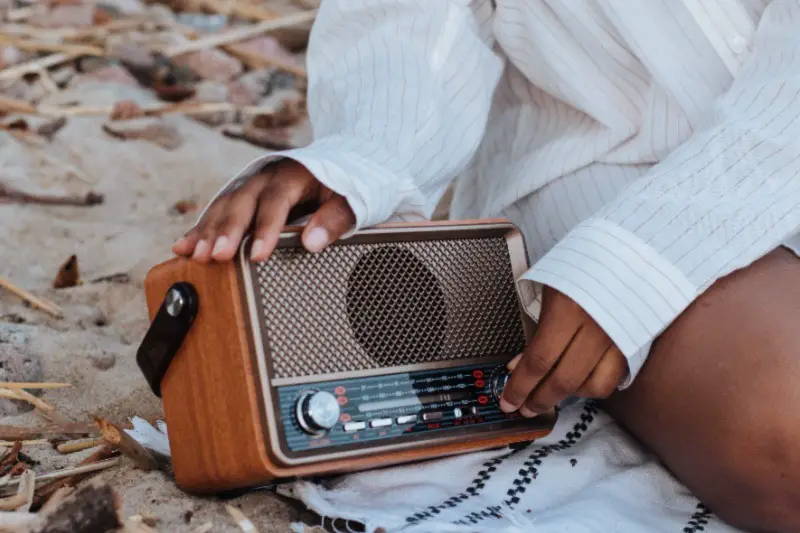Radios have been around for ages, long before we all started binge-watching shows online or scrolling through news feeds.
They were the main source of tunes and news back in the day.
Now, we’re taking a fresh look at these old-school devices but with an eco-friendly twist.
So, how does a solar-powered radio work?
These radios use sunlight, turning it into the energy they need to keep playing your favorite stations.
This means you don’t need to plug them in or keep buying batteries.
In this guide, I’ll walk you step by step through the mechanics of a solar-powered radio, explaining just how these devices can play music using nothing but sunlight.
Key Takeaways
- A solar-powered radio harnesses sunlight to generate electricity, either powering the device directly or charging its internal battery.
- Key components include photovoltaic cells, a rechargeable battery, and radio circuitry for sound processing.
- To use, simply position the solar panel in sunlight, connect it to the radio, and allow time to charge.
- Additional features may include a hand crank, USB port, integrated flashlight, and emergency signals.
What Is a Solar-Powered Radio?
A solar-powered radio is a device that uses solar panels to grab energy from sunlight and turn it into electricity.
The electricity from the solar panels can either power the radio right then and there or charge up a battery inside it for later use.
This makes the radio super handy because it doesn’t need regular batteries or a plug-in source to work.
It’s perfect for trips out in nature, emergencies when power is out, or if you’re trying to be more eco-friendly.
Plus, it helps cut down on waste from disposable batteries and reduces reliance on non-renewable energy sources.
What Are the Components of a Solar-Powered Radio?
1. Solar Panel
The solar panel is like the powerhouse of a solar-powered radio.
It’s comprised of many tiny units called photovoltaic (PV) cells, all connected.
They take sunlight and turn it into electricity—pretty cool, right?
This happens because when sunlight hits these cells, they get the material’s electrons all excited, creating electrical energy.
Now, this electricity from the solar panel is used in two main ways.
First, it can power the radio right away.
So, if it’s sunny, you can listen to your tunes or catch the news immediately.
Second, the electricity can be stored in a battery inside the radio for later use.
2. A Rechargeable Battery
The rechargeable battery in a solar-powered radio is like a power bank—it stores up extra energy when there’s plenty of sunlight.
This way, the radio has a stash of power to tap into whenever it needs to, especially when the sun isn’t out to help.
Here’s how it works: when the sun is shining bright, the solar panel works hard and sometimes makes more electricity than the radio needs right then.
Instead of letting this extra power go to waste, the battery stores it.
Later, if it gets cloudy or turns to night, the radio uses this stored energy to keep going.
3. Radio Circuitry
The radio circuitry is the brain of the operation of a solar-powered radio.
It’s what turns all that electrical energy into the music or news you hear.
Inside the radio, many tiny electronic components, like transistors and semiconductors, handle different parts of this job.
First, the circuitry picks up radio signals through its antenna.
These signals are weak when they first arrive, so the circuitry has to amplify them.
That’s where those transistors come in, boosting the signals so that they’re strong enough to work with.
Next, the semiconductors help by processing these amplified signals, and fine-tuning them into something that sounds clear and crisp.
Finally, once the signals are all set, they’re sent to the radio’s speaker, where they’re transformed into sound waves you can hear.
How to Use a Solar-Powered Radio?
Using a solar-powered radio is simple and all about making the most of the sun.
Here’s how you can get your radio up and running:
- Find the Perfect Spot: First up, place your solar panel where it can soak up lots of direct sunlight. The more sun it gets, the better it works!
- Hook It Up: Grab the cable that came with your radio. Plug one end into the solar panel and the other end into the radio’s charging port. It’s just like plugging in any other device.
- Check the Connection: Make sure everything’s plugged in tight. If the connections are loose, your radio might not charge properly, which can be a real bummer.
- Let It Charge: Once everything’s connected and secure, the solar panel will start doing its thing, turning sunlight into electricity that charges your radio’s battery.
- Give It Time: The amount of charging time needed can vary. It depends on how strong your solar panel is and how big the radio’s battery is. Just give it enough time to fully charge up, and you’ll be all set.
What Additional Features That Might a Solar-Powered Radio Have?
1. Hand Crank Option
Some solar-powered radios come with a cool add-on—a hand crank.
This isn’t just any crank; it’s connected to a little gadget inside called a dynamo.
What it does is pretty neat: when you turn the crank, the dynamo spins and turns your muscle power into electricity.
This means even when there’s no sunshine, like on cloudy days or at night, you can still get your radio to work by simply cranking it by hand.
It’s a real game-changer in situations where light is scarce or in emergencies when you need to keep that radio running.
Plus, the power you generate can either keep the tunes coming directly or charge up the radio’s battery for later.
2. USB Port for Charging
Some solar-powered radios come with a super handy feature—a USB charging port.
You can think of it as a mini power station.
When you’re out camping or find yourself in a pinch without power, you can just plug your phone or other small devices right into the radio’s USB port.
The best part?
It uses the power stored in the radio’s battery, so you can keep your gadgets charged up even when there’s no outlet in sight.
3. Integrated Flashlight
How cool would it be if your radio could also light up your path?
Well, some solar-powered radios come with a bright, integrated flashlight that does just that.
It’s not just a tiny light; it’s strong enough to light up the night, making it perfect if you’re camping and need to navigate in the dark, digging through your emergency kit, or just finding your way back to your tent.
The best part?
It also runs off the same battery that powers the radio, so no need to fuss with extra batteries.
Just flip a switch, and you’ve got a dependable light source right at your fingertips.
4. Emergency Signal Features
And there’s more—some solar-powered radios come with a feature that could come in handy in a pinch—emergency signal features.
If you’re in a tough spot, like getting lost on a hike or stuck in a bad storm, your radio can send out SOS signals or even sound a loud alarm to grab attention.
Just a simple push of a button, and it’s all systems go.
This makes the radio a must-have for anyone who loves an adventure or just likes to stay prepared.
FAQs
How to Charge a Solar Radio?
To charge a solar radio, position the solar radio in direct sunlight to enable the built-in solar panel to capture solar energy and charge the internal battery.
What Are the Benefits of Solar Radios?
The benefits of solar radios include that they use renewable solar energy, reduce reliance on electricity or batteries, and are particularly useful in remote or emergencies.
What Does a Solar-Powered FM Receiver Do?
A solar-powered FM receiver captures FM radio signals using solar energy, allowing you to listen to music, news, and broadcasts without needing external power sources.
Conclusion
Just like we promised, we’ve explored how solar-powered radios use sunlight to keep your tunes and news coming, all without needing to plug in or swap out batteries.
These handy gadgets are perfect for camping or when the power’s out, and they’re great for the planet too.
Here’s a tip to get the most from your solar radio: keep the solar panel clean.
A clean panel catches more sunlight, which means more power for your radio.
Do you still have questions about how solar-powered radios work or why they’re such a cool choice?
Feel free to drop them in the comments!
Join our solar microdosing newsletter and get bite-sized, easy-to-understand insights into the world of solar energy.
From how solar panels work to building your own DIY solar system, we’ve got you covered.




